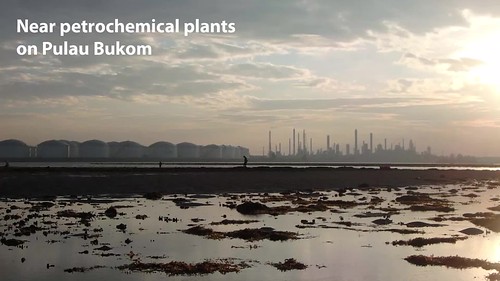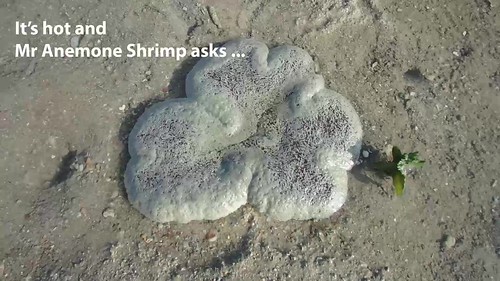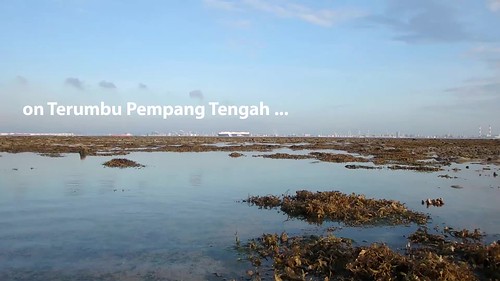It was good to see fresh seagrass growths and no coral bleaching!
This large submerged reef flat has lots of Leathery soft corals, hard corals and other marine life.
Even though it is next to petrochemical plants of Pulau Bukom and Jurong Island.
The large patch of Branching montipora corals near our favourite landing point is alive and well. No bleaching in sight.
The reef flat is dotted with many large boulder shaped Merulinid corals (previously called Favid corals). Those I saw were not bleaching.
As usual, the most common hard corals remain Pore corals and Merulinid corals previously called Favid corals.
I also saw some Anemone corals and Small goniopora corals and they were not bleaching. We couldn't get to the reef edge to see some of the special corals because the Sargassum was still in bloom.
I saw several Cauliflower corals and Asparagus flowery soft corals. They were not bleaching. In the past, these are the first to bleach/
The corals at Marina Keppel Bay were mostly alright, although there was one small bleaching colony.
A few of the Leathery soft corals were oddly coloured (greenish), I saw one small yellowish Spiky flowery soft coral (might be its normal colour) and a few tiny hard corals that were bleaching.
As usual, there are clumps of small sponges, small corals, with seaweeds, sponges and other marine life dotting the area. Among the crabs I saw (but didn't photograph) were small Swimming crabs, and many Hairy crabs.
In pools of water, there are clumps of corals and seaweeds and other colourful animals.
I came across several small Magnificent anemones, a few Giant carpet anemones some with hidden anemonefishes, and two Haddon's carpet anemones.
One of the anemones had a very selfish anemone shrimp!
Some creatures that I noticed for the first time on this reef are Yellow clustered bead ascidians, and the Blue-spotted flatworm that probably eats them.
I am really heartened to see nice fresh green seagrasses. The Tape seagrasses were rather long, there were many patches of Spoon seagrasses with large and small leaf blades, and also sprinklings of Sickle seagrasses. The seagrasses are still patchy and not so dense like at Cyrene Reef. But on our last trip in Jun 2015, the seagrasses were heavily covered in ephiphytes. Today, they were nice and clean.
Here's a video of the seagrasses today.
Terumbu Pempang Tengah is close to an area designated for parking of large unused construction sea vessels such as cranes, barges and huge work boats.
Terumbu Pempang Tengah is also close to the Live Firing Islands and as we were leaving, we heard two loud thumps and saw smoke rising from probably Pulau Senang. This is why it is important not to stray into the Live Firing Area.
On the way home, we take a closer look at a barge that is parked close to Terumbu Semakau. It is the SSE ANNE and Alex teaches me to see how it is not just parked (with one buoy) but anchored in place (with four buoys) so it is probably used for work at the site. A check and from PORT MARINE NOTICE NO. 20 OF 2016 dated 7 Mar 2016, it is part of an "Underwater Communication and Networking Experiment off North of Pulau Semakau" that will take place from 8 Mar 2016 to 18 Mar 2016.
The experiment includes the deployment of acoustic communication nodes, and AUV by work boats in the area marked on the chart. Divers will be on standby during the deployment and recovery of acoustic communications nodes and ADP. Further enquires relating to the project can be directed to Dr Venu, Senior Research Fellow at Tel: 8147-1997 (email: tmsvp@nus.edu.sg).
At the start of the trip, in the dark, the flaring at the petrochemical plants on Pulau Bukom is more obvious. I was surprised when I got back to receive an update from Shell about some issues that resulted in "flaring with intermittent dark smoke" that they are working to resume normal operations. It's good to know that they are reaching out to the marine community about such issues.
It has indeed been a good day for engagement with the marine community. After the trip, I attended a special gathering for marine environmentalists organised by the Maritime and Port Authority (MPA). It included a lovely walk of maritime heritage sites (which I missed because I was on the morning trip), a tour of the Singapore Maritime Gallery, a lovely lunch followed by a discussion of volunteering with MPA's marine conservation programmes. More photos in my facebook album.Here's the location of the submerged reef we visited today. 'Tengah' means 'middle' in Malay, while 'Laut' means 'seaward' and 'Darat' means 'landward'. These beautiful submerged reefs may be affected by reclamation in the future.
The 2030 Landuse Plan by the Ministry of National Developmentreleased in Jan 2013 shows plans for 'possible future reclamation' (in light blue surrounded by dotted lines) that may impact Terumbu Pempang Darat and Terumbu Pempang Tengah. More about thepossible impact of the 2030 Landuse Plan on our shores.
 |
| Click on image for larger view. |
 |
| Click on image for larger view. |
Photos by others on this trip
- Russel Low on facebook
- Jianlin Liu on facebook.
- Jonathan Tan on facebook.
- Marcus Ng on facebook.
- Juria Toramae on facebook.
























